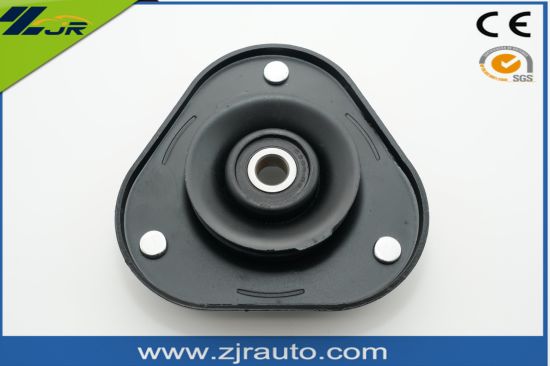Views: 10 Author: Site Editor Publish Time: 2024-02-05 Origin: Site








The smooth operation of a vehicle relies on various interconnected components, and one critical element often overlooked is the strut mount. Strut mounts play a pivotal role in the suspension system, contributing to a comfortable ride, enhanced stability, and overall safety. In this article, we will delve into the importance of strut mounts, their functions, and the signs that indicate potential issues.
What Are Strut Mounts?

Strut mounts are crucial components in a vehicle's suspension system, connecting the strut assembly to the vehicle's body. The suspension system is responsible for managing the impact of uneven road surfaces, ensuring a smooth ride, and maintaining stability during maneuvers. Strut mounts are positioned at the top of the struts and serve as a link between the strut assembly and the vehicle's chassis.
Functions of Strut Mounts

▼Support and Alignment:
Strut mounts provide essential support to the vehicle's suspension system, helping to distribute the weight of the vehicle evenly across all four wheels. Proper weight distribution is critical for maintaining stability and preventing uneven tire wear.
▼Vibration Dampening:
As the vehicle encounters bumps, potholes, or rough surfaces, the suspension system absorbs the shocks and vibrations. Strut mounts play a key role in dampening these vibrations, preventing them from transferring to the vehicle's body and ensuring a more comfortable ride for the occupants.
▼Flexibility and Movement:
Strut mounts allow for controlled movement of the suspension system, enabling the wheels to adapt to changes in the road surface. This flexibility is essential for responsive steering, better handling, and improved overall performance.
▼Isolation of Noise:
Strut mounts help isolate noise and vibrations generated by the suspension system, preventing them from reaching the vehicle's cabin. This not only enhances the driving experience but also contributes to a quieter and more enjoyable ride.
Types of Strut Mounts

▼OEM (Original Equipment Manufacturer) Strut Mounts:
These are the strut mounts that come with the vehicle when it is first manufactured. OEM strut mounts are designed to meet the specific requirements and standards set by the vehicle's original manufacturer.
▼Aftermarket Strut Mounts:
Aftermarket strut mounts are produced by third-party manufacturers and are available for replacement purposes. They often come with additional features or improvements, providing vehicle owners with options for upgrading their suspension system.
▼Performance Strut Mounts:
Performance-oriented strut mounts are designed for enthusiasts looking to enhance their vehicle's handling and responsiveness. These mounts typically offer improved durability, better vibration dampening, and enhanced overall performance.
Signs of Struts Mount Issues

▼Unusual Noises:
A common indicator of struts mount problems is the presence of clunking, banging, or rattling noises when driving over bumps. These noises suggest that the struts mount may be loose or damaged, allowing for excessive movement.
▼Uneven Tire Wear:
If the struts mount is failing, it can lead to improper wheel alignment, resulting in uneven tire wear. Inspecting the tires for irregular tread wear patterns can help identify potential struts mount issues.
▼Steering Issues:
Damaged or worn struts mounts can affect the vehicle's steering responsiveness. If you notice difficulty steering, increased steering effort, or a lack of precision in steering control, it may be indicative of struts mount problems.
▼Visible Wear and Tear:
Inspecting the struts mounts for visible signs of wear, such as cracks, corrosion, or rubber deterioration, can provide insight into their condition. Any visible damage may warrant immediate attention and replacement.
Maintenance and Replacement
▼Regular Inspections:
Routine inspections of the suspension system, including the struts mounts, are crucial for identifying issues early on. Regularly checking for signs of wear or damage can help prevent more extensive and costly repairs in the future.
▼Replacement Intervals:
While the lifespan of struts mounts can vary depending on driving conditions and vehicle usage, it is generally recommended to replace them every 50,000 to 100,000 miles. Following the manufacturer's guidelines and consulting with a mechanic can help determine the appropriate replacement interval for your specific vehicle.
▼Professional Assessment:
If you experience any of the signs mentioned earlier or suspect issues with your vehicle's strut mounts, it is advisable to seek a professional mechanic's assessment. They can conduct a thorough inspection and provide recommendations for replacement or repairs as needed.
In conclusion, strut mounts are integral components of a vehicle's suspension system, contributing to its overall performance, comfort, and safety. Understanding their functions, recognizing signs of potential issues, and adhering to regular maintenance practices are essential for ensuring a smooth and reliable driving experience. By giving due attention to strut mounts, vehicle owners can prolong the lifespan of their suspension system and enjoy the full benefits of a well-maintained and properly functioning vehicle.